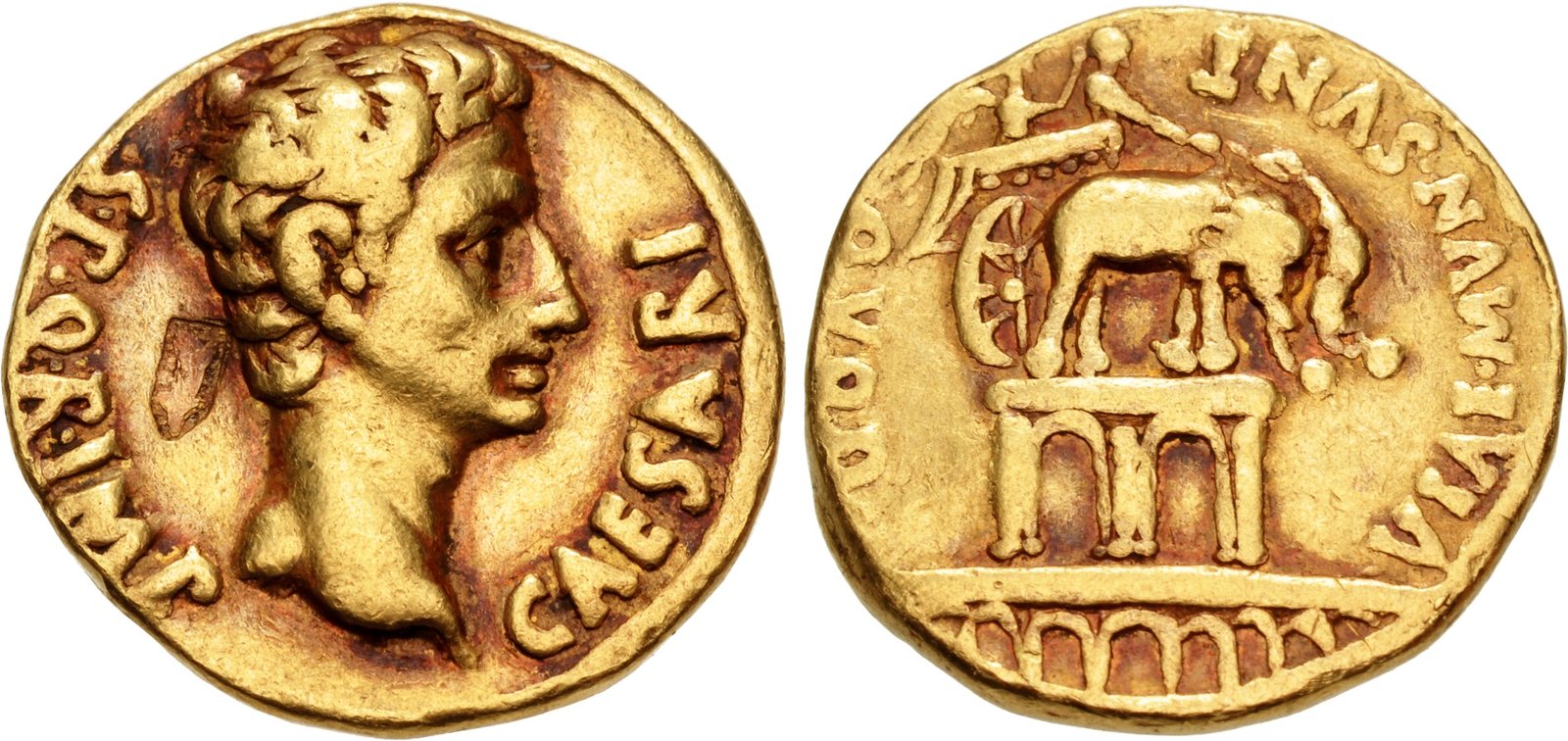A Brief History of Roman Coins
Early Coinage Origins – The Republican Period
Long before Rome was the superpower of the Mediterranean, money looked a lot different. Early Romans traded with bronze lumps — the famous aes rude — which were basically chunks of metal by weight. Then came aes grave, big cast coins so heavy they could almost be used as paperweights. By the early 3rd century BC, Greek influence from southern Italy started to seep in, and Rome began striking coins instead of casting them. The real turning point came around 211 BC with the birth of the denarius. It was neat, round, easy to carry, and often decorated with gods, heroes, and reminders of who was in charge. Republican coins weren’t shy about celebrating a good military victory or an important family name — they were like little bronze and silver bragging rights.
Imperial Expansion & Propaganda Role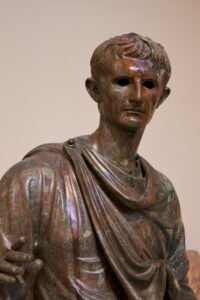
When Augustus took control in 27 BC, coins stopped being just money. They became mini billboards for the emperor. Instead of abstract symbols, you’d now see his portrait front and center, the same in every corner of the empire. And the reverse? That was the storytelling side — showing victories, temples, new roads, or even grain handouts to the people. For a collector, this period is pure gold (and silver, and bronze) because it’s so varied. Take Trajan, for example — one year he’s celebrating a massive bridge over the Danube, the next he’s honoring a conquered province. These coins are like time capsules that tell you exactly what message Rome wanted to send.
Late Empire Debasement & Reforms
By the 3rd century AD, cracks were showing. Wars, inflation, and shaky politics meant the silver content in coins started to plummet. The proud denarius faded away, replaced by coppery antoniniani that barely looked silver at all. Then came the reformers — Diocletian, with his follis (bronze with just a whisper of silver on top), and Constantine, whose solidus was so pure and consistent it would outlast the empire in the East. Late Roman coins can feel a bit rougher, smaller, sometimes rushed — but that’s part of their charm. They show a Rome fighting to hold itself together, and every coin you hold from this era carries that history in its worn edges.
How Ancient Roman Coins Were Made: A Collector’s First-Hand Look Into the Mint
I remember the my first time when I held some Roman coins. It was a silver denarius and some bronze coins, too. I felt so good my fantasy exploded, a little worn around the edges, but it made me pause. Someone, nearly two thousand years ago, held that same coin in their hand. They spent it at a market or paid a soldier with it. But how exactly was it made?
That question sent me down the rabbit hole of Roman minting — and what I found made me admire these coins even more. They’re not just bits of metal. They’re historical fingerprints, each one hammered out by hand in a time before machines and mass production.
Roman Coin Values
One of the first questions new collectors ask is, “What’s it worth?”
The honest answer: it depends. Condition, rarity, the emperor on the obverse, and even the mint where it was struck can all change the price. Some common coins sell for the cost of a nice lunch; others have fetched six figures at auction.
I’ve written a separate guide that digs into values, price trends, and real examples from past sales. If you’re buying or selling, it’s worth a read.
➡️ Read the Roman Coin Values guide »
Identifying Roman Coins
At first glance, a Roman coin can look like a jumble of worn letters and a mystery portrait. But with a few pointers, you can start making sense of them. Latin inscriptions reveal the emperor’s name, symbols hint at political messages, and mintmarks tell you where it was made.
I’ve broken all of this down in an easy-to-follow identification guide. It’s a mix of tips, photos, and the same tricks I used when I was learning.
➡️ Go to the Identifying Roman Coins guide »
Why Collect Roman Coins?
Some collectors chase rarity. Others love the history. Personally, I think Roman coins hit the sweet spot — they’re affordable enough to start small, but deep enough that you can spend years exploring without running out of new discoveries. And every single coin, no matter how worn, has a story.
So take your time, follow the links above, and start your own journey. Just be warned: once you get your first Roman coin, it’s hard to stop.
Main Types of Roman Coins
Roman coins came in all shapes, sizes, and metals — from tiny copper pieces that would’ve bought you a loaf of bread, to gleaming gold aurei that screamed wealth and power. The most famous is probably the silver denarius, but there’s a whole family of coins, each telling its own story.
If you want to see how they all fit together, I’ve put together a guide that walks you through each denomination, what it looked like, and how it was used.
➡️ See the full Main Types of Roman Coins guide »
Gold Coins – Aureus & Solidus 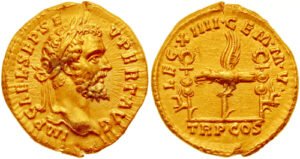
Gold was the elite’s currency. During the Republic and early Empire, the aureus reigned supreme — a small, dense coin usually worth 25 silver denarii. The weight and purity were remarkably consistent, which is why aurei still have that satisfying “perfect coin” feel in hand. By the time of Constantine in the 4th century AD, the aureus had given way to the solidus. The solidus was thinner, slightly lighter, but incredibly stable in value — so much so that it became the backbone of Byzantine trade for the next 700 years. Gold coins are rare finds today, often tied to major historical figures. Holding one, you’re holding what would have been a year’s wages for a Roman soldier.
(Internal link: Top 25 Roman Gold Coins)
Silver Coins – Denarius, Antoninianus & More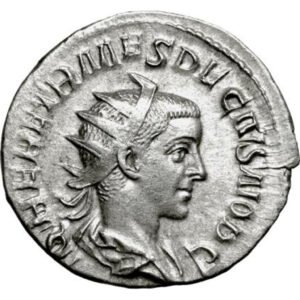
The denarius is the coin most people picture when they think “ancient Rome.” First struck in 211 BC, it was the workhorse of the Roman economy for centuries. Early denarii shine with fine portraits and crisp legends, but by the 3rd century AD they’d been replaced by the antoninianus — a slightly larger coin with less and less silver as time went on. You can often spot early antoniniani by the radiate crown on the emperor’s head. For collectors, silver coins offer the best mix of affordability and artistry, ranging from mint-state Republican issues to heavily worn Late Empire pieces that passed through countless hands.
(Internal link: Roman Silver Coin Values)
Bronze Coins – Sestertius, As, Follis & Beyond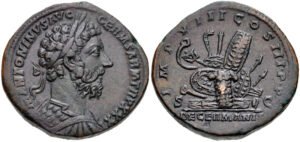
Bronze coins were the real “people’s money” of Rome. In the early Empire, the sestertius was a large, impressive piece often used to showcase intricate designs — think triumphal arches, city personifications, and detailed portraits that could rival silver coins. Smaller bronzes like the as or dupondius were more practical for daily transactions. By the 4th century, bronze coins had shrunk dramatically, with the follis becoming the standard. Even at their smallest, these coins can surprise you with sharp imagery — a soldier spearing a fallen enemy, a camp gate, or the Chi-Rho symbol of Constantine’s Christian empire.
(Internal link: Top 25 Roman Bronze Coins)
For the collector, every metal tells a different story:
-
Gold whispers of emperors and high politics.
-
Silver captures the pulse of trade and military pay.
-
Bronze brings you down to the streets of ancient cities, where the everyday life of Rome unfolded in copper tones.
—
🔨 Where It All Started: From Bronze Blobs to Real Coins
Long before Rome became an empire, people were using rough bronze lumps called aes rude as money. You didn’t carry a wallet back then—you probably carried a pouch of scrap metal to weigh and barter with.
Eventually, they got smarter and began casting actual coins—aes grave—using molds and molten bronze. These were thick and round and looked more like tokens than coins.
But the real leap happened when the Romans picked up the Greek technique of striking coins. That changed everything. Now, instead of casting metal, they hammered designs into blank discs—what we now call flans. That’s when Roman coinage as we know it really began.
—
🔧 The Minting Process (Hands, Hammers, and a Lot of Noise)
Making a Roman coin wasn’t glamorous. It was loud, hot, and repetitive. But every step mattered.
1. Cutting and Shaping the Flans
The process started with metal — gold, silver, bronze, or a mix like billon. Workers would melt it down, pour it into rods or molds, and then slice it into little discs. These were the flans, the blanks that would become coins.
But they weren’t always perfect. Some flans came out too thick, some too thin. They’d be reheated, hammered, or filed down to get the weight right. A Roman mint wasn’t a factory—it was a workshop, and sometimes a messy one.
2. Engraving the Dies
The real artistry came in the form of dies—small metal blocks carved with designs. One for the front (called the obverse), usually showing the emperor or a god. The other for the back (reverse), which might have a military scene, a temple, or a mythical creature.
These were carved by hand, often by skilled engravers. And because nothing was mechanized, no two dies were exactly the same. That’s part of the charm—each coin carries slight differences depending on who made it and when.
3. Striking the Coin
With flan and dies ready, it was time to strike.
The lower die sat fixed in an anvil. A worker placed the flan on top of it. The upper die was lined up above, and then—wham!—a hammer came down hard, imprinting the design on both sides in a split second.
But these weren’t modern machines. They missed, they slipped, they hit too hard or too soft. And because of that, you get all those fascinating errors we collectors love.
—
⚠️ Minting Mistakes That Make Coins More Interesting
If you’ve ever seen a Roman coin with a doubled face or a weird off-center look—those are minting errors. And unlike modern coins, where errors are rare, Roman mints were full of them.
Common Roman Coin Mistakes:
Double strikes – The flan shifted, and the worker hit it again.
Off-center – The die wasn’t lined up, so part of the design got cut off.
Overstrikes – Old coins were reused, hammered over with new designs.
Cracks and splits – Caused by cold metal or poor flan quality.
Strangely, these flaws are part of what makes Roman coins so collectible. They’re physical proof that these were made by people, not machines.
—
🏛️ Who Was Behind the Roman Coins?
In the Republic, a group called the Triumviri Monetales was in charge of coin production. Their names sometimes appear on coins, which is pretty incredible—imagine having your name stamped into currency that would outlive you by two millennia.
Later, under the Empire, the process became more centralized. Mints were placed in cities across the empire—Rome, Antioch, Alexandria, Lugdunum (modern Lyon)—each with its own style and quality.
And they weren’t sloppy about it. Coins were weighed. Silver was tested. There was quality control. But when times got tough—like during wars or inflation—you can tell the difference. The coins get thinner, the designs more rushed. It’s all there in the metal.
—
🪙 A Word About the Denarius
Ask any collector, and they’ll probably say the denarius is their favorite. It was the silver coin that powered Rome for centuries. Soldiers were paid in it. Markets used it. Emperors used it to spread messages.
Some of the most iconic coins ever made were denarii:
Julius Caesar’s elephant coin
Augustus’ celebration of Pax Romana
Hadrian’s coins with provinces and cities
You can see the whole empire’s story unfold through these coins. And that’s what makes collecting them such a rich experience.
—
🧠 Why It Matters (and How It Helps Collectors)
Knowing how Roman coins were made isn’t just interesting—it’s useful.
You’ll start noticing things: Why this coin is off-center. Why another has a tiny crack. Why the portrait looks different from others minted in the same era.
You’ll spot fakes more easily—because modern machines can’t replicate the irregular, hand-struck charm of a real Roman coin. And you’ll get better at grading, too, because you understand what wear looks like compared to a weak strike.
—
📥 Want More? Grab the Minting & Error Guide (Free PDF)
I’ve put together a visual guide you can download for free. It shows:
Common minting errors (with photos)
Basic grading tips
Signs of authentic vs. fake strike patterns
> 📥 Download the Roman Minting & Error Guide (PDF)
—
✅ Ready to Link This Article With:
How to Grade Roman Coins
Identifying Fakes in Ancient Coinage
💬 Final Thoughts About Roman Coins
There’s something grounding about Roman coins. Each one was touched by someone. Struck by hand. Used in a market. Buried. Forgotten. And then, centuries later, found again.
We collectors aren’t just buying coins—we’re holding history.
So next time you look at a Roman coins, take a second to imagine the moment it was made: the heat, the hammer, the hands behind it.
